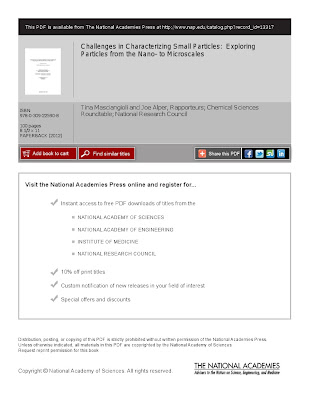Small particles—about one nanometer to tens of microns—are ubiquitous in the natural and engineered worlds. They are in the air, soil and water on Earth, as well as at the farthest reaches of the universe. One of the major buzz words during the past 10 years, nanotechnology, involves the creation of nanoscale materials with the promise of new and revolutionary properties.
Given the size and abundance of small particles, however, there is relatively little understanding about their properties and chemical composition, which limits our ability to understand, predict and control their applications and impacts in both natural and engineered systems. At the same time, information may be available that just needs to be shared across disciplinary boundaries to increase understanding of small particles.
The Chemical Sciences Roundtable (CSR) was established in 1997 by the National Research Council. It provides a science-oriented apolitical forum for leaders in the chemical sciences to discuss chemistry-related issues affecting government, industry and universities. Organized by the National Research Council’s Board on Chemical Sciences and Technology, the CSR aims to strengthen the chemical sciences by fostering communication among the people and organizations—spanning industry, government, universities and professional associations— involved with the chemical enterprise. One way it does this is by organizing workshops that address issues in chemical science and technology that require national or more widespread attention.
Click here to read the complete report.
The CSR held a 1.5-day workshop that explored new opportunities, challenges and approaches to characterizing small particles and understanding their impacts. Small particles—about one nanometer to tens of microns—are ubiquitous in the natural and man-made worlds. In many scientific and engineering domains, uncertainty about the properties and chemical composition of small particles limits our ability to understand, predict and control their applications and impacts.
The workshop included several overview presentations highlighting the critical importance of small particles in environmental science, materials and chemical sciences, biological science and engineering. In addition, several presentations highlighted new advances in characterizing small particles, including static, dynamic, experimental, computational and theoretical approaches.
This document summarizes the presentations and discussions that took place at the workshop. In accordance with the NRC’s policies, the workshop did not attempt to establish any conclusions or recommendations about needs and future directions, focusing instead on issues identified by the speakers and workshop participants. In addition, the organizing committee’s role was limited to planning the workshop. This workshop summary has been prepared by the rapporteurs Joe Alper and Tina Masciangioli as a factual summary of what occurred at the workshop.
Fonte: Laboratory Equipment
Given the size and abundance of small particles, however, there is relatively little understanding about their properties and chemical composition, which limits our ability to understand, predict and control their applications and impacts in both natural and engineered systems. At the same time, information may be available that just needs to be shared across disciplinary boundaries to increase understanding of small particles.
The Chemical Sciences Roundtable (CSR) was established in 1997 by the National Research Council. It provides a science-oriented apolitical forum for leaders in the chemical sciences to discuss chemistry-related issues affecting government, industry and universities. Organized by the National Research Council’s Board on Chemical Sciences and Technology, the CSR aims to strengthen the chemical sciences by fostering communication among the people and organizations—spanning industry, government, universities and professional associations— involved with the chemical enterprise. One way it does this is by organizing workshops that address issues in chemical science and technology that require national or more widespread attention.
Click here to read the complete report.
The CSR held a 1.5-day workshop that explored new opportunities, challenges and approaches to characterizing small particles and understanding their impacts. Small particles—about one nanometer to tens of microns—are ubiquitous in the natural and man-made worlds. In many scientific and engineering domains, uncertainty about the properties and chemical composition of small particles limits our ability to understand, predict and control their applications and impacts.
The workshop included several overview presentations highlighting the critical importance of small particles in environmental science, materials and chemical sciences, biological science and engineering. In addition, several presentations highlighted new advances in characterizing small particles, including static, dynamic, experimental, computational and theoretical approaches.
This document summarizes the presentations and discussions that took place at the workshop. In accordance with the NRC’s policies, the workshop did not attempt to establish any conclusions or recommendations about needs and future directions, focusing instead on issues identified by the speakers and workshop participants. In addition, the organizing committee’s role was limited to planning the workshop. This workshop summary has been prepared by the rapporteurs Joe Alper and Tina Masciangioli as a factual summary of what occurred at the workshop.
Fonte: Laboratory Equipment

